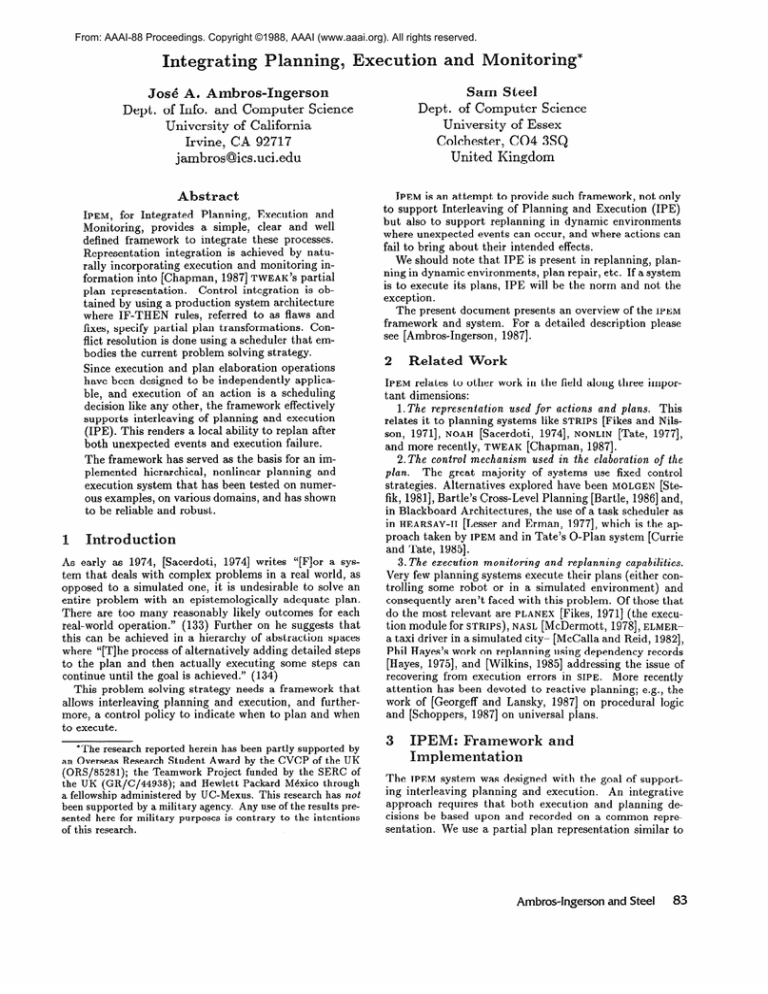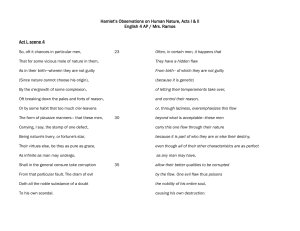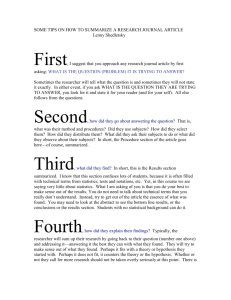
From: AAAI-88 Proceedings. Copyright ©1988, AAAI (www.aaai.org). All rights reserved.
Integsat ing Planning, Execution and Monitoring*
Jo&
Sam Steel
Dept. of Computer Science
University of Essex
Colchester, CO4 3SQ
United Kingdom
A, Ambros-Engerson
Dept. of Info. and Computer Science
University of California
Irvine, CA 92717
jambros@ics.uci.edu
Abstract
IPEM, for Integrated Planning, Execution and
Monitoring, provides a simple, clear and well
defined framework to integrate these processes.
Representation integration is achieved by naturally incorporating execution and monitoring information into [Chapman, 19871 TWEAK'S partial
plan representation. Control integration is obtained by using a production system architecture
where IF-THEN rules, referred to as flaws and
fixes, specify partial plan transformations. Conflict resolution is done using a scheduler that embodies the current problem solving strategy.
Since execution and plan elaboration operations
have been designed to be independently applicable, and execution of an action is a scheduling
decision like any other, the framework effectively
supports interleaving of planning and execution
(IPE). This renders a local ability to replan after
both unexpected events and execution failure.
The framework has served as the basis for an implemented hierarchical, nonlinear planning and
execution system that has been tested on numerous examples, on various domains, and has shown
to be reliable and robust.
1
Pntroduction
As early as 1974, [Sacerdoti, 19741 writes “[Flor a system that deals with complex problems in a real world, as
opposed to a simulated one, it is undesirable to solve an
entire problem with an epistemologically adequate plan.
There are too many reasonably likely outcomes for each
real-world operation.” (133) Further on he suggests that
this can be achieved in a hierarchy of abstraction spaces
where “[Tlhe process of alternatively adding detailed steps
to the plan and then actually executing some steps can
continue
until the goal is achieved.”
(134)
This problem solving strategy needs a framework that
allows interleaving
planning and execution,
and furthermore, a control policy to indicate when to plan and when
to execute.
*The research reported herein has been partly supported by
an Overseas Research Student Award by the CVCP of the UK
(ORS/85281);
the Teamwork Project funded by the SERC of
and Hewlett Packard MCxico through
the UK (GR/C/44938);
a fellowship administered by UC-Mexus. This research has ~aot
been supported by a military agency. Any use of the results presented here for military purposes is contrary to the intentions
of this research.
IPEM is an attempt to provide such framework, not only
to support Interleaving of Planning and Execution (IPE)
but also to support replanning in dynamic environments
where unexpected events can occur, and where actions can
fail to bring about their intended effects.
We should note that IPE is present in replanning, planning in dynamic environments, plan repair, etc. If a system
is to execute its plans, IPE will be the norm and not the
exception .
The present document presents an overview of the IPEM
framework and system. For a detailed description please
see [Ambros-Ingerson, 19871.
elated
2
Work
IPEM relates to other work in the field along three important dimensions:
l.The
representation
used for actions and plans.
This
relates it to planning systems like STRIPS [Fikes and Nilsson, 19711, NOAH [Sacerdoti, 19741, NONLIN [Tate, 19771,
and more recently, TWEAK
[Chapman, 19871.
2.The control mechanism
The great majority
plan.
used in the elaboration
of the
of systems use fixed control
strategies. Alternatives explored have been MOLGEN
[Stefik, 19811, Bartle’s Cross-Level Planning [Bartle, 19861 and,
in Blackboard Architectures, the use of a task scheduler as
in HEARSAY-II [Lesser and Erman, 19771, which is the approach taken by IPEM and in Tate’s O-Plan system [Currie
and Tate, 19851.
3.The
execution
monitoring
and replanning
capabilities.
Very few planning systems execute their plans (either controlling some robot or in a simulated environment) and
consequently aren’t faced with this problem. Of those that
do the most relevant are PLANEX [Fikes, 19711 (the execution module for STRIPS), NASL [McDermott, 19781, ELMERa taxi driver in a simulated city- [McCalla and Reid, 19821,
Phil Hayes’s work on replanning using dependency records
[Hayes, 19751, and [Wilkins, 19851 addressing the issue of
recovering from execution errors in SIPE. More recently
attention has been devoted to reactive planning; e.g., the
work of [Georgeff and Lansky, 19871 on procedural logic
and [Schoppers, 19871 on universal plans.
3
HPEM: Framework
plernentation
and
The IPEM system was designed with the goal of supporting interleaving planning and execution. An integrative
approach requires that both execution and planning decisions be based upon and recorded on a common representation.
We use a partial plan representation
similar to
Ambros-Ingerson
and Steel
83
the one used in other systems (e.g., TWEAK), extended to
include the current world description, the actions in the
process of being executed, etc. We also maintain a decision list that records the history of the problem solving
process (e.g., for backtracking).
A problem solving strategy that interleaves planning and
execution should not be constrained by dependencies between planning and execution operations. Thus, all our
transformations - the flaws and fixes that are used to elaborate and execute a plan - were designed to preserve the
well-formedness and semantics of partial plans and can be
applied independently of each other.
Our bias has been to design plan transformations that
are clean, simple and composable, instead of powerful ones,
that are often complex and ad-hoc.
Complex powerful
transformations are obtained by the application of a sequence of simple ones.
We use a production system architecture since it provides the flexibility in control that we need [Lesser and Erman, 19771. IF-THEN rules map to flaws and fixes in our
framework. A flaw is .a property or condition in a partial
plan that corresponds to the IF part of an IF-THEN rule;
each fix - there is usually more than one - corresponds to
the THEN part, and specifies a plan transformation to get
rid of (i.e., fix) the flaw. Conflict resolution is done using a scheduler that embodies the current problem solving
strategy along with weak and domain specific heuristics.
Alternative options at a choice point are retained so that
full backtracking is supported whenever possible.
IPEM has been implemented in C-Prolog at Essex
(Sun3/50 and GEC-63) as the core of a multi-actor planning and execution system [Doran, 19871. It allows the
user to input unexpected events at any stage of execution and plan development. The examples presented here,
and others that involve interactions in a multi-actor setting
[Doran, 19861, run satisfactorily. The system is currently
being used at Essex for research in plan delegation and
organization emergence [Doran, 19881.
3.1
Assumptions
Our action representation is - by historical accident, since
it was developed independently - almost identical to Chapman’s TWEAK, so all his assumptions are our assumptions
(e.g.,STRIPS assumption).
We further assume a continuously updated Current
World Description (CWD), in the form of a set of ground
We do not assume the
( i.e., variable free) propositions.
description is complete but we do assume it contains no
errors of commission. We don’t make the closed world assumption. Note however, that:
we do not assume a static world - the CWD can
change while the plan is being elaborated, possibly
making the current partial plan inapplicable;
actions can fail to achieve its intended effects; partial
success is exploited;
actions are not assumed to achieve their effects immediately - in fact, different effects of the same action
can have different delays without preventing the execution of those parts of the plan that can be safely
executed, and;
we don’t assume the CWD holds all the information
84
Automated Reasoning
needed to elaborate a complete, detailed plan at planning onset - so the problem may be unsolvable without interleaving planning and execution.
We say that an incomplete (partial) plan P necessarily
satisfies property S if S holds in every possible completion
(elaboration) of P. It p ossibZy satisfies S if there is at least
one completion that satisfies S. See [Chapman, 19871 for
more details.
3.2
Plan Elaboration
.
The plan transformations used to elaborate the plan are
very similar to those used in other systems (e.g., NONLIN,
We will only give a brief description here.
TWEAK).
A (well-formed) partial plan’ consists of:
1. a partially ordered set of actions including two special
ones, BE&N
(the minimum) and END (the maximum)
- the postconditions (effects)of BEGIN are the propositions in the CWD and the goals to be achieved are
the preconditions of END.
2 a set of (protection) ranges - each range connects
a postcondition (supplier) with a precondition (consumer) indicating the (sub)goal dependency and requiring both propositions to necessarily codesignate
(necessary codesignation is equivalent to unification).
Note that the supplier has to be necessarily before the
consumer.
The initial partial plan has of two actions, BEGIN and
END, to which the following transformations are applied.
3.2.1
Unsupported
Precondition;
Reduce
An action A in the plan with a precondition with no
range (i.e., it has no assigned producer) has an unsupported precondition
flaw. The postcondition to be used as
producer for the new range can be assigned in any of three
ways:
1. by simple establishment on an action already in the
prior),
plan which is necessarily before A (reduction
or
2. by simple establishment on an action B already in the
plan which is possibly before A (reduction parallel). B
is now constrained to be necessarily before A; or
3. on a new step (action) now added to the plan (reduction new).
3.2.2
Unresolved
Conflict;
Linearize
A plan with a range R that protects proposition p and an
action A, possibly after the producer and possibly before
the consumer of R that asserts the negation of Q, where
p and q necessarily codesignate, has an unresolved
conflict flaw (clobbering).
This is fixed by promotion (A is
constrained to be necessarily after the consumer of R) or
demotion (A is constrained to be necessarily before the
producer of R). In both cases the plan is partially linearized.
3.2.3
Unexpanded
Action;
Expand
A plan with an action which is expandable (i.e., not
action flaw. Actions and
primitive) has an unexpanded
their expansions up and down the hierarchy are linked
‘See [Ambros-Ingerson, 19851 for a detailed definition of
well-formed partial plan.
(e.g.,
by their pattern - an action based description
‘dance
style’) - and codesignation of patterns constrain
variable bindings in the same way as with ranges. Expansion consists of replacing such action (together with the
ranges attached to it) with an appropriate expansion instance - a partial plan in itself (e.g., a sequence of foot
moves that realize the dance).
This contrasts with the state based description expressed
through pre and post-conditions that reduction uses (e.g.,
an action that takes ‘foot@locl’ to ‘foot@loc2’).
3.2.4
Completeness
and
Correctness
A comparison between IPEM'S and TWEAK'S plan transformations shows that IPEM has no fixes equivalent to separation and white night while TWEAK
has no action expansions. Can we claim IPEM complete and- correct?
Correctness follows from the fact that both IPEM and
TWEAK
detect the same set of flaws. Provided expansion
schemas are correct, their inclusion in the plan can’t generate incorrect plans (although they can certainly introduce
new flaws). In fact, action expansions can be defined in
terms of a sequence of reductions and linearizations.
Although our clobbering (unresolved conflict) definition
is narrower than TWEAK's (it requires necessary instead of
possible codesignation), we can show that they only yield
different results on plans that are complete except for unbound variables in the post-conditions of some action(s).
There is more than one way to define the semantics of executing such an action. We return to this issue in Section 5.
Completeness follows from noticing that a white knight
fix is equivalent to replacing a range with a far producer for
one with a closer one. This transformation can be avoided
by selecting the final producer correctly in the first place.
The same argument holds for separation; it can be avoided
by selecting bindings right in the first place. Note that the
completeness claim has to be dropped if unexpected events
or execution failure is allowed, since the notion is ill defined
in this case.
What can be affected is the efficiency of plan generation.
If used with the same search regime, IPEM will probably
backtrack more often because it posts more stringent constraints than it needs to. Our selection of few fixes however, matches our bias for simplicity referred to previously.
3.3
Plan
Monitoring
and Execution
We extend the action representation to accommodate the
necessities of execution and monitoring. We associate a
procedure and a time-out with every primitive action as
explained below.
3.3.1
Unsupported
Range;
Excise
Range
A plan with a range R produced by BEGIN, protecting
a proposition no longer in the CWD, has an unsupported
range flaw. Note that ranges produced by BEGIN are precisely those propositions in the CWD that are currently
relied upon (assumed) by the partial plan.
Excising R fixes this flaw but automatically creates an
unsupported precondition on R’s consumer. On the other
hand, since the codesignation constraint is also removed (it
is part of the range) new bindings might be permissible.
The effect of the REINSTANTIATE
operator in SIPE
[Wilkins, 19851 is analogous to the application of an ex-
cise range followed by a reduction prior on BEGIN.
return to this relationship in Section 4.
3.3.2
Unexecuted
Action;
We
Execute
A plan with an action ready for execution has an unexecuted action flaw. We consider an action A ready for
execution if
A is primitive and not END;
all its preconditions have ranges produced by BEGIN,
none of which is unsupported;
it is immediately after an executed action (BEGIN is
considered executed);
it is not involved in an unresolved conflict flaw; and
there is no “live” action B (i.e., not timed-out) before
A that expects a post-condition that can clobber any
of A’s post-conditions.
Executing the action consists of :
e adding order constraints so that all parallel actions
are made necessarily after A;
8 calling the associated procedure (after substitution of
the appropriate bindings) which in turn should instruct some effector to carry out a movement, a measurement, etc.;
B) if active monitoring by a lower level system is desired,
posting the action’s postconditions as expected; and
e recording that the action has been executed.
Note that the action is kept in the plan (see time-out below).
Although this execution model does not allow simultaneous execution initiation, it does allow the execution initiation of actions before their predecessors have finished
(timed-out). Thus, if the planner’s cycle is fast with respect to execution completion times, actions executing in
parallel can be present.
3.3.3
Timed
Out
Action;
Excise
Action
An executed action times out when no further effects are
expected to come about as consequence of its execution.
Note that time-out is not defined in terms of success or
failure; every action must time-out, whether it achieved
its intended effects or not.
Fixing this flaw entails removing the action - together
with all the ranges for which some postcondition is a producer or some precondition a consumer - from the plan.
We previously pointed out that actions are kept in the
plan when executed. It’s important to note that this is consistent with the semantics of an action in a partial plan.
In fact, since incorporating the expected effects into the
postconditions of BEGIN would violate the semantics of the
CWD, deleting the action from the partial plan would necessitate the creation of new structures to record the expected effects and their interaction with other parts of the
plan. Wowever, this is what planning is all about and is
done for every action in the plan. So why duplicate this
effort in another structure? An unexecuted action and an
executed one that hasn’t timed-out are both predicting a
future state of affairs over which the same kind of planning
reasoning applies.
3.3.4
Unextended
Range;
Extend
Range
If, in a plan, we can remove a range R and replace it
with a range R’ where
Arnbros-Ingerson and Steel
85
o R and R’ have the same consumer;
o the Droducer of R’ is before the Droducer of R: and
e the new range R’ does not create an unresolved conflict flaw (clobber);
we have an unextended
range flaw. The fix is to replace R
with R’, which can be seen as extending range R on the
producer side to the location of the producer of R’; hence
its name: range extension.
We distinguish the special case where the producer of the
new range is BEGIN and the consumer is a post-condition
of an executed action A. In this case the appearance of
the proposition at BEGIN that makes the extension possible can be correlated with a (partially, at least) successful
execution’ of A.
The general case where no execution has taken place can
be considered to be a serendipitous occurrence, especially
if the extension is to some postcondition of BEGIN. Range
extensions have to be done with care in the general case
(only) since there is a tradeoff between having long ranges,
that are more likely to generate interactions, and short
ones, that take no advantage of serendipitous occurrences
to remove redundant actions.
L
x
3.3.5
Redundant
Action;
Excise
Action
A plan with an action A not producing for any range
(i.e., no range has A as producer) has a redundant action
flaw. Excising the action - its fix - can result in further
action redundancies since ranges are removed along with
the action.
3.4
Control:
The
Scheduler
Conflict resolution for the application of a given fix at a
given moment is done through a scheduler similar to the
one used in HEARSAY-II [Lesser and Erman, 19771. It maintains an agenda (priority queue) of tasks. Each task consists of a flaw, along with its possible fixes. Tasks and fixes
for a flaw are ordered using weak and user supplied domain
heuristics.
Although the search space is not a strict AND-OR
graph, we use some of the heuristics that work well there.
Since all flaws have to be fixed, we select the one that is
“harder” to fix, and select the fix that introduces less constraints into the partial plan (e.g., in the case of reductions,
the preference order we use is prior, parallel and new).
In our runs we have set to fix flaws in the following
order: unsupported range, unextended range, timed-out
action, unresolved conflict, unsupported precondition, unexpanded action, unexecuted action. Within a flaw class,
the flaw which appears harder to fix (e.g., has only one fix)
is preferred. If some flaw has no fixes, then backtracking
is attempted when possible.
3.4.1
Backtracking
The system uses full chronological backtracking up to
decision points that involve non-backtrackable fixes (e.g.,
excision of an unsupported range caused by an unexpected
event, action execution, etc.). Beyond this point two genera1 approaches can be taken, where the choice is domain
and case dependent. Note however, that all replanning
options will be attempted before backtracking is chosen.
The first is to ignore such decision points (they have
only one fix anyway) and carry on up the tree to other
8G
Automated Reasoning
choice points with open alternatives. Note however that
completeness is compromised; e.g., it is possible that the
very same option currently being backtracked over is now
viable thanks to a just occurred unexpected event.
Alternatively, we can scrap the old plan and start afresh
on a new plan with the same goals. Simplicity makes this
approach more appealing.
4
Unexpected
Events
and Replanning
This section will illustrate IPEM’S replanning adaptability to both a dynamic world and to execution failure. This
example is very similar to the one presented by Wilkins
[Wilkins, 19851 and fits the scenario proposed by Schoppers [Schoppers, 19871, where a mischievous baby makes
the state of the world all but static.
The goal is to achieve ((a on c) A (u.x on r.y)) from the
blocks configuration presented in Figure 1:i. The initial
plan (move a from b to c) in parallel to (move u.z from t.5
to r.1) is at the top left labeled ‘i’.
Before execution of this plan can commence, our baby
(moves d from t.3 to r.1).
This causes the addition of
((clear t.3) A (d on 1.1) A -(d on t.3) A -(clear r.l)) to the
CWD creating an unsupported range flaw on (clear r.1).
The range is excised, creating an unsupported precondition
on (clear z), which is fixed by reduction prior on (clear r.2)
(see ii). The overall effect is very similar to the REINSTANTIATE operator described by Wilkins [Wilkins, 19851.
At this point our baby interferes again, (moving a from b
to u.2). This interferes with both actions in the plan. Two
unsupported ranges result; for (clear u.2) and for (a on b).
The ranges are excised, generating the corresponding unsupported preconditions for (clear u.2) and (a on y). The
first one is fixed by reduction parallel to the effect (clear y)
of the action moving block a (now necessarily before as a
consequence of the constraint that for a given range, the
producer is necessarily before the consumer). The second
one is fixed with a reduction prior to (a on u.2) at BEGIN.
The resulting plan is shown at ‘iii’: (move a from u.2 to c)
followed by (move u.2 from t.5 to r.2).
There is an unexecuted action flaw on the first action,
now fixed by execution.
The effector starts by picking
block a up. (clear u.2) is added to the CWD, generating
an unextended range flaw, fixed by extension. Now the
effector screws up and bumps into d and r.1 producing
the state shown in ‘iv’. Now the action times-out (say
the manipulator sends a signal indicating it bumped into
something and that it is no longer attempting to carry out
the procedure) and must be excised. This generates an
unsupported precondition at (a on c) of END. Note that
execution of (move a from u.2 to c) was partly successful
and that IPEM took notice; execution of (move u.2 from t.5
to r.2) could have proceeded if another manipulator were
available even though the other action hadn’t timed-out
yet.
A number of other propositions are added to the CWD
as a consequence of the bumping (e.g., (clear r.l), (d on c), (a on u.2), etc.). The unsupported precondition for (a on c)
is now fixed with two reduction new fixes and a number of
reduction priors. The resulting plan is shown in ‘iv’.
It is important to point out the adaptability displayed by
IPEM under unexpected events and execution failure. This
it shares with reactive planners (e.g., [Schoppers, 19871,
I, clear
d
-clear
clear
I
z
w
...
:;:;: :+---.aclear
z -c1ear
t
1..
111
a on u.2-+2Jea.;;
-a on b
>
BEGIN
-clear
-xon
xon
y
.z P
move a
from
u.2 to c
w
I clear
u.2
move
u.2
from
t.5 to r.2
y-clear
x
3
-x on y
pu.x
END
on r.y I
...
clear
t.1
t.2
t.3
t.4
1-clear
2 clear
t.5
a on u.10
clear aa
2
y
t.6
t.1
t.2
t.3
t.4
t.5
t.6
oxon
aclear
t.1
t.2
t.3
t.4
t.5
t.6
y -clear
x I -xon
t.1
2
y
t.2
t.3
t.4
t.5
t.6
Figure 1: Replanning after unexpected events and execution failure.
[Firby, 19871). On th e other hand it retains the flexibility
and power of a hierarchical nonlinear planner. It is capable
of dealing with action interactions where reactive planners
are incapable of doing so.
5
Interleaving
Planning
and Execution.
We are having dinner with Sandy. When having dinner with somebody we want that somebody to like the food and we also need to have
the food. We don’t know what Sandy likes but
it does make a difference since the choice determines the restaurant, the way to dress, whether
to make a reservation, etc. Asking is a way of
finding what a person likes.
This example illustrates a class of problems that can
hardly be solved without interleaving planning and execution. A conditional plan is a poor option since it must
plan for a potentially large number of alternatives, most of
which won’t be used. On the other hand, replanning after
execution failure can be harmful to our relationship with
Sandy.
To solve this problem using IPEM we need to make an
extension to the action representation to cope with information acquiring actions (IAA’s). TWEAK'S semantics define an otherwise complete plan with an unbound variable
on the postconditions of an action to be completed to any
constant. This is unsatisfactory for an action which yields
a particular - yet unknown - value when executed.
We introduce a new set of variables, Ivan to handle such
actions. The variable in the postcondition intended to provide information in an IAA is defined as an Ivar. We allow Ivar’s to codesignate with variables, but not with constants. The scheduler is slightly modified to put on hold
those flaws whose fixes would bind an Ivar to a constant.
This results in plan elaboration up to the point where all
flaws are on hold with the exception of unexecuted actions,
then chosen for execution by the scheduler.
For example, consider Figure 2. The top presents a plan
to solve our dining example problem, where thing is an
Ivar at ASK, our IAA action. At this point every expansion for GET meal in the action schema repertoire known
to the system would bind meal to some constant. Since
meal codesignates with thing its expansion is placed on
hold. Note that this is the maximally elaborated plan that
doesn’t commit the binding of meal.
Unexecuted action at ASK is the only remaining flaw
not on hold. ASK is executed and made necessarily before
GET meal (see bottom of Figure 2). “Sandy likes fondue”
is eventually added to the CWD creating an unextended
range from DINE to BEGIN. The range is extended (the solid
range added, the dotted one removed) so that meal now
codesignates with a constant (fondue) and not with thing.
Planning can proceed now that it has been established that
the correct expansion for GET meal is GET fondue.
Note that an action has been executed before the plan
was fully elaborated and the outcome of its execution was
used to decide the expansion to use (i.e., for a planning
Arnbros-lngenon
and Steel
87
meal
ASK
DINE
GET
meal
have
meal
I have /
I meal
-
END
dinner
withguest
dinner
with
Sandy
ligence
meal
X
BEGIN
3
ASK
-
GET
meal
__fi
DINE
I...
havemeal
have
meal
>
END
dinner
dinner
with W-O with
guest
Sandy
Figure 2: Interleaving Planning and Execution
decision).
Gsnclusions
IPEM successfully integrates the processes of planning, execution and monitoring. Control integration was obtained
by using a production-system architecture where the IFTHEN rules operate as transformations between partial
plans. In IPEM’S context IF-THEN rules are referred to as
flaws and fixes. Representation integration was achieved
bY using a common partial plan representation extended
to include monitoring and execution information.
The primary goal of providing a system to support interleaving of planning and execution in a principled and
clear way has been attained.
Furthermore, the system exhibits a robust capacity to
replan either after execution failure or after the o&urrence
of unexpected effects. One must caution however, that this
capability is seriously limited by its locality.
A planning and execution system embodying the framework has been successfully implemented. It has been tested
on numerous examples from various domains, including the
ones in this document. It is currently being used at Essex
in research concerning Multi-Actor systems [Doran, 19881.
Acknowledgements
Many thanks must go to Jim Doran for support, encouragement and valuable insights and suggestions. We
also thank David Aha, Tony Lawson, Chris Trayner, Edward Tsang and Wayne Wobcke for useful comments in
the course of this research.
References
[Ambros-Ingerson,
19851 J. A. Ambros-Ingerson.
Plan-
Master’s
thesis, University of Essex, Colchester CO4 3SQ, U.
K., 1985.
[Ambros-Ingerson, 19871 J. A. Ambros-Ingerson.
IPEM:
Integrated planning, execution and monitoring. M.
Phil. Dissertation, University of Essex, Colchester
CO4 3SQ, U. K., 1987.
[Bartle, 19861 R. A. Bartle. Three Ways to Cross-Level
Plan. Technical Report CSM-84, University of Essex,
University of Essex, Colchester CO4 3SQ, U.K., 1986.
ning;
88
a Theory,
an Application
Automated Reasoning
and
the
Modelding
of Sociocultural
Systems.
Technical Report CSM-87, University of Essex, Colchester CO4 3SQ, U.K., September 1986.
thing
fondue
[Chapman, 19871 David Chapman. Planning for conjunctive goals. Artificial Intelligence,
32:333-377,
1987.
[Currie and Tate, 19851 K. Currie and A. Tate. Control
in the Open Planning
Architecture.
Technical Report AIAI-TR-12, Artificial Intelligence Applications
Institute, Edinburgh, U.K., 1985.
[Doran, 19861 Jim E. Doran. . Distributed Artificial Intel-
and a Tool.
Investiga[Doran, 19871 Jim E. Doran. A Computational
tion of Three Models of Specialisation,
Exchange
and
Social Complexity.
Technical Report, University of
Essex, Colchester CO4 3SQ, U.K., August 1987.
[Doran, 19881 Jim E. Doran. The structure and emergence
of hierarchical organisations. In Alvey Workshop on
Multiple Agent Systems,
Philips Research Labs, Redhill U.K., April 1988.
[Fikes, 19711 Richard E. Fikes. Monitored
Execution
of
Robot Plans Produced by STRIPS.
Technical Note 55,
Stanford Research Institute, 1971.
[Fikes and Nilsson, 19711 R. E. Fikes and N. J. Nilsson.
Strips: a new approach to the application of theorem
proving to problem solving. Artificial Intelligence,
2:189-208, 1971.
[Firby, 19871 R. J. Firby.
An investigation into reactive planning in complex domains.
In AAAI’87,
pages 202-206, 1987.
[Georgeff and Lansky, 19871 M. P. Georgeff and A. L. Lansky. Reactive reasoning and planning. In AAAI’87,
pages 677-682, 1987.
[Hayes, 19751 P. J. Hayes. A representation for robot
plans. In IJCAI’75,
pages 181-188, 1975.
[Lesser and Erman, 19771 V. R. Lesser and L. D. Erman.
A retrospective view of the Hearsay-II architecture.
pages 27-35, 1977.
In IJCAI’V,
[McCalla and Reid, 19821 G. I. McCalla and L. Reid. Plan
creation, plan execution and knowledge acquisition in
a dynamic microworld. International
Journal of Man
Machine Studies, 16:189-208, 1982.
[McDermott, 19781 Drew McDermott. Planning and acting. Cognitive Science, 2:71-109, 1978.
[Sacerdoti, 19741 Earl D. Sacerdoti. Planning in a hierarchy of abstraction spaces. Artificial Intelligence,
5:115-135, 1974.
[Schoppers, 19871 M. J. Schoppers. Universal plans for reactive robots in unpredictable environments. In IJCAI’87, pages 1039-1046, 1987.
[Stefik, 19811 M. Stefik.
Planning and meta-planning
$I$gIen;70p;ar~I 1 and 2).
Artificial
Intelligence,
[Tate, 19771 Austin Tate. Generating project networks. In
IJCAI’77,
pages 888-893, 1977.
[Wilkins, 19851 D. E. Wilkins. Recovering from execution
errors in SIPE. Computational
Intelligence,
1:33-45,
1985.







